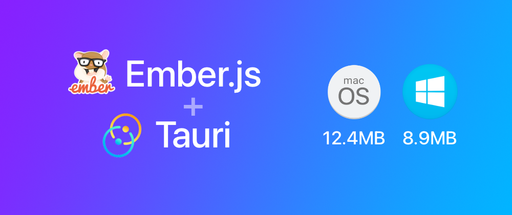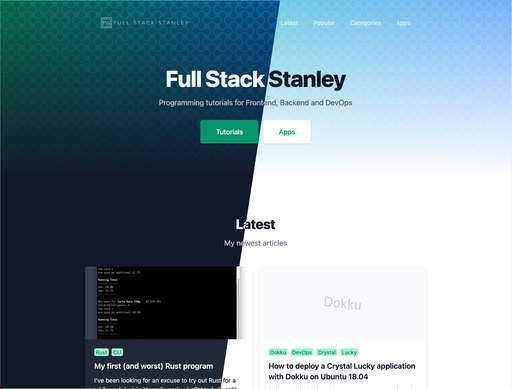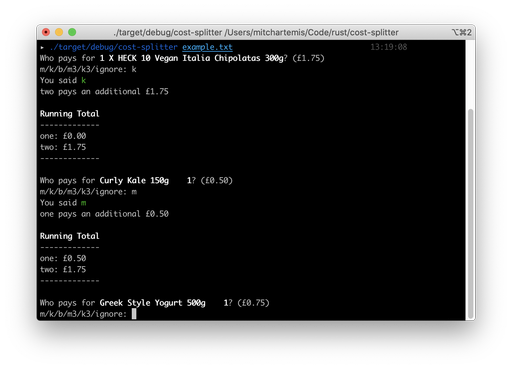After listening to the Ruby Rogues’ Padrino episode I was sold on the idea of using Padrino for smaller websites and simple API’s. I know Grape is also a perfect contender for building an Ember APIs but:
- I am already familiar with Sinatra so the learning curve shouldn’t be as steep.
- I wanted to get to know Padrino.
- Funsies.
I’m going to show you how to quickly set up both together, build a restful API compatible with Ember’s
ActiveModelAdapterand show you a few gotchas to help you on your way.
Note
This article is aimed at people familiar with Ruby and have some understanding of the MVC pattern (ideally with Padrino or Rails). This article is not a guide for starting out with Padrino. If you have previous Ruby web framework experience you’ll most likely catch on quick.
On the Ember side of things you should be comfortable with Javascript, Ember and ideally Ember-CLI.
I will try to explain everything I do but this article is more about getting the two frameworks to work together.
You can view the full source for both of these articles on Github.
Getting Started
Make sure you have Padrino and Ember-CLI installed. With Ruby and NPM this should be a matter of gem install pardrino, npm install -g ember-cli and npm install -g bower.
See Padrino’s Installation Guide and Ember CLI’s Getting Started for more details.
For reference I’m using the following library versions:
- IO.js 1.2.0 (Also tested with Node 0.10.36)
- NPM 2.5.1
- Ember-cli 0.1.15
- Ember 1.8.1
- Ember-data 1.0.0-beta.14.1
- Bower 1.3.12
- ruby-2.1.1
- Padrino 0.12.4
For a directory structure to this article we want 3 directories.
- Blog
|- API
|- App
Make Blog main directory and change in to it.
mkdir Blog && cd Blog
Setting up Padrino
One of the features of Padrino I love the most is the ability to swap different libraries to your preference. For instance, you have the choice to use your preferred ORM. If you know Rails then you will most likely be comfortable with ActiveRecord.
I have recently been dabbling with Sequel and will be using it for this tutorial as I have become quite fond of it.
Run the following commands to set up Padrino
padrino g project API -d sequel -t minitest
cd ./API
bundle
Check the Generators documentation for more options. You can specify css precompilers, Javascript libraries and mocking libraries as well. As they are not really relevant to this article I have left them off.
Open up your Gemfile in API/Gemfile and add the following gems:
gem 'rabl'
gem 'oj'
gem 'rack-cors', :require => 'rack/cors'
# Optional
group :development do
gem "better_errors"
end
RABL stands for “Ruby API Builder language” and let’s us generate JSON for our API incredibly easily. I have to say, I found the documentation incredibly useful and I have found examples for every use case I’ve needed so far.
Oj is a RABL dependancy for “speed optimized JSON handling”.
Rack/CORS “provides support for Cross-Origin Resource Sharing (CORS) for Rack compatible web applications.”
Better Errors makes debugging so much easier. You can remove it for the tutorial but I do recommend using it in your own applications.
Run bundle to install the new dependancies.
For the sake of keeping the article short we will be creating the API in one Padrino application but it is possible to mount multiple Padrino apps within one another.
We could have one app mounted to api/v1/ and then, if we plan to upgrade our API, it’s as simple as mounting another app to api/v2/.
Take a look at the Mounting Applications documentation for more information on mounting apps. Also check here for generating the sub-applications.
The Model
Keeping things simple, we’ll have one CRUD API for managing blog posts using using the default sqlite database.
We’ll make the model called Post that has 5 fields, id, title, content, created_at and updated_at
padrino g model Post title:string content:text created_at:datetime updated_at:datetime
This will create 3 files, your model, a migration file and a file for your model tests.
Open the migration file located in db/migrate/001_create_posts.rb and change the updated_at field to be nullable.
Sequel.migration do
up do
create_table :posts do
primary_key :id
String :title
Text :content
DateTime :created_at
DateTime :updated_at, null:true
end
end
down do
drop_table :posts
end
end
When using Sequel you can migrate your database to the latest migration with this rake command:
rake sq:migrate:up
To make our timestamp columns behave like Ruby on Rails we need to add the Sequel timestamp plugin in our config/database.rb.
Sequel::Model.plugin(:timestamps)
In the models/post.rb add the following line:
class Post < Sequel::Model
Sequel::Model.plugin :timestamps
end
This line will sort out updating created_at and updated_at when necessary.
The Controller
Run the following to generate the controller:
padrino g controller Posts get:index post:create get:show patch:update delete:destroy
This will create our controller in app/controllers/post.rb. We can see in the command we’ve deliberately left out new and edit methods from our CRUD API. This is because Ember has no need to query them (at least it won’t for our simple application).
Running rake routes we’ll see how we can interact with the routes.
URL REQUEST PATH
(:posts, :index) GET /posts
(:posts, :create) POST /posts/create
(:posts, :show) GET /posts/show
(:posts, :update) PATCH /posts/update
(:posts, :destroy) DELETE /posts/destroy
Let’s make it so api/v1 is prepended and for familiarity we’ll also modify our routes to mirror Rail’s conventions found here.
In app/controllers/post.rb change it to the following:
Edit: Big thanks to Nathan Esquenazi for showing me a much cleaner way of doing it. For reference you can see my previous code here
Api::App.controllers :posts, map: "api/v1/posts" do
get :index, map: "" do
end
post :create, map: "" do
end
get :show, map: ":id" do
end
patch :update, map: ":id" do
end
delete :destroy, map: ":id" do
end
end
If you run rake routes now you should see the following:
(:posts, :index) GET /api/v1/posts
(:posts, :create) POST /api/v1/posts
(:posts, :show) GET /api/v1/posts/:id
(:posts, :update) PATCH /api/v1/posts/:id
(:posts, :destroy) DELETE /api/v1/posts/:id
Much better. Now let’s fill in the details
require 'json'
Api::App.controllers :posts, map: "api/v1/posts" do
get :index, map: "" do
@posts = Post.all
render "posts/index"
end
post :create, map: "" do
parameters = post_params
if parameters["post"].nil?
return '{}'
end
@post = Post.create parameters["post"]
render "posts/show"
end
get :show, map: ":id" do
@post = Post[params[:id]]
render "posts/show"
end
put :update, map: ":id" do
@post = Post[params[:id]]
if @post.nil?
return '{}'
end
parameters = post_params
@post.update parameters["post"]
render "posts/show"
end
delete :destroy, map: ":id" do
@post = Post[params[:id]]
@post.delete unless @post.nil?
end
end
def post_params
JSON.parse(request.body.read)
end
If you're familiar with Active Record you should see some familiar method names. all, create, delete and update are self explanatory. You may be unfamiliar with how Sequel finds specific rows, though.
Post[params[:id]] is the simplest way to retrieve a record by primary key. params[:id] is just the URL id parameter. So it's more like calling Post[1].
Occasionally we return blank objects with
return '{}'
This may seem unneeded but Ember expects a valid JSON response and if it doesn't get one it will throw a hissy fit.
Views
Now we’ll get the JSON responses working. Sequel and RABL make this nice and easy.
Create these two files:
app/views/index.rabl
collection @posts, root: "posts", object_root: false
attributes :id, :title, :content, :created_at, :updated_at
app/views/show.rabl
object @post
attributes :id, :title, :content, :created_at, :updated_at
If you’ve never used RABL before this may look quite alien to you.
We use the collection method when working with multiple objects and the object method when specifying one object in particular.
The collection method has two parameters, root and object_root. root specifies the parent key that wraps around the collection. We set object_root to false because by default RABL adds another key around each row.
Essentially we are changing this JSON:
[{
"post":
{
"id":1,
"title":"test",
"content":"test",
"created_at":"2015-02-11 20:25:21 +0000",
"updated_at":null
}
}]
To this Ember-friendly JSON
{
"posts":
[{
"id”:1,
”title":"test",
"content":"test",
"created_at":"2015-02-11 20:25:21 +0000",
"updated_at":null
}]
}
Lastly, the attributes method lets us choose which data we want to show in our API.
A word on CSRF Protection
The problem
With Rails and Ember-Rails it’s possible to set up CSRF protection by having an API end-point that provides the CSRF token. That token is then placed in a meta tag called csrf_token and then with Ember you set up an AJAX preFilter which sends the token in a header named X-CSRF-Token.
All this is possible with Padrino’s csrf_token method, but due to the fact that your API and Ember-CLI are separate applications you will not have access to the session which verifies the token.
The solution
You have 2 options. Disable CSRF entirely or, if your Padrino app is more than just an API, disable it for your API.
Disabling CSRF Entirely
Go to app/config/apps.rb and set the following
set :protect_from_csrf, false
If your app is currently running make sure you restart it now with bundle exec padrino start.
Disabling CSRF for your API
If you’re using Better Errors, go to app/config/apps.rb and set the following
set :protect_from_csrf, except: %r{/__better_errors/\\w+/\\w+\\z} if Padrino.env == :development
If your app is currently running make sure you restart it now with bundle exec padrino start.
In app/controllers/posts.rb we need to disable CSRF for any requests that aren’t get. We can do that by setting csrf_protection: false in the parameters.
require 'json'
Api::App.controllers :posts, map: "api/v1/posts" do
get :index, map: "" do
@posts = Post.all
render "posts/index"
end
post :create, map: "", csrf_protection: false do
parameters = JSON.parse(request.body.read)
if parameters["post"].nil?
return '{}'
end
@post = Post.create parameters["post"]
render "posts/show"
end
get :show, map: ":id" do
@post = Post[params[:id]]
render "posts/show"
end
put :update, map: ":id", csrf_protection: false do
@post.update params
render "posts/show"
end
delete :destroy, map: ":id", csrf_protection: false do
@post = Post[params[:id]]
@post.delete unless @post.nil?
end
end
CORS
We will be using Ember-CLI’s proxy option so we don’t have to worry about CORS. However for production you may want to include it.
In app/app.rb Add the following lines of code to your App class
use Rack::Cors do
allow do
origins '*'
resource '*', :headers => :any, :methods => [:get, :post, :options, :delete, :patch]
end
end
If you look at the Rack/CORS documentation, you can specify URLs that are allowed to access your API by updating the origins method.
origins 'localhost:4200' # Ember CLI App
Before moving on to Part 2 make sure your Padrino app is up and running. Use bundle exec padrino start.
Summary
That’s it for part 1. We’ve successfully made an API compatible with Ember’s ActiveModelAdapter. We’ve disabled CSRF where necessary and enabled CORS.
Click here to view part 2 for implementing the Ember side of the project.






